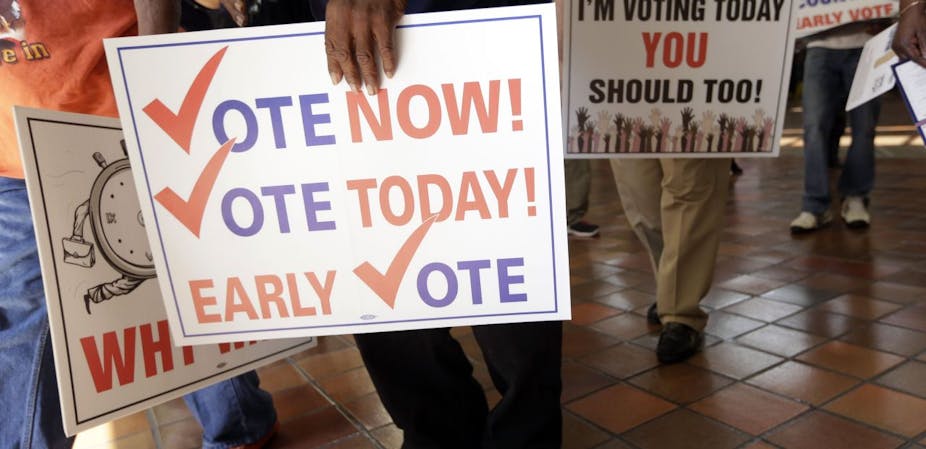In the final Election Day push, more and more focus is being shifted to the “ground game,” or the effort campaigns make to identify and turn out voters. From Massachusetts to Alaska, New Hampshire to Colorado, candidates have invested in a last-minute effort to reach their voters. However, too many of these campaigns—and the stories written about them—misunderstand what a successful ground game really is. Too often, they put their hope in the tools instead of the people who use those tools.
Lessons from the Obama campaigns
If we examine the most successful ground game in recent history, we see that a successful field operation is built not only by investing in the tools (big data and technology), but also the people who use them. The 2008 and 2012 Obama campaigns inspired more activism than any other campaign in history.
In 2012, Obama for America (OFA) field organizers engaged 2.2 million volunteers, mobilized by 10,000 neighborhood teams, and led by 30,000 volunteer leaders. The scale of the Obama operations dwarfed previous campaigns, such that, as journalist Sasha Issenberg predicts, future candidates will be asking for an “Obama-style ground game.”
As we describe in our book, Groundbreakers: How Obama’s 2.2 Million Volunteers Transformed Campaigning in America, the Obama campaign achieved this level of activism by making a long-term investment in developing volunteer leadership.
For decades, most campaigns relied more heavily on staff for their ground game because, they thought, only paid employees could be pushed to put in the long tedious hours needed to make voter contact. Volunteers were considered too risky because they could not be depended on to show up consistently or to produce the phone calls and door knocks the candidate needed.
The Obama campaign bet on volunteers, gambling that if they developed the motivations, skills, and capacities of ordinary Americans to organize their communities, they could win.
Volunteers are king
One 2008 Ohio training document, for example, read: “Volunteer recruitment and retention is the most important aspect of our field program. We cannot achieve the sheer volume of what we need in order to win without their help.” Ohio field organizer Tony Speare explained, “Rather than trying to do all the work ourselves, the idea was to spend the majority of our time building up volunteer teams and then making them self-sufficient so that [they could do the work].”
The Obama campaign built a field operation that gave volunteers the responsibility, training, and interpersonal support needed to take charge of their own communities. Instead of asking volunteers to make rote phone calls, stuff envelopes, or distribute yard signs, OFA asked them to take responsibility for measurable electoral outcomes.
Consider the Obama campaign’s use of house meetings. In contrast to relying only on paid staff, organizers asked volunteers to take charge of hosting a dozen of their neighbors in the most intimate of settings: their home. At these house meetings, supporters and undecided voters would “do what used to be truly American: sit around and talk about, ‘What do we want for our family? What do we want for our country? What is our responsibility?’” as one of our interviewees put it.
Ellen Gangnon, one of the Obama campaign’s volunteer leaders from Wisconsin, recalled inviting more than 100 guests to her house meeting, almost as if she was planning a wedding. “I ended up with 24 or 26 people…at my party. From there we developed a really, really nice team. Some of the attendees are still [organizing] with me today!”
Gangnon was not a prototypical Obama voter, let alone volunteer. She had voted for George W. Bush in both 2000 and 2004 -— so it’s unlikely that should would have appeared on one of the Democrats’ targeting lists. But because the Obama campaign made it possible for Gangnon to build community with other voters in a face-to-face setting, she committed to a leadership role, investing more than 40 hours a week in her team for no pay during the election.
Building civic infrastructure
Gangnon’s story exemplifies the difference between the Obama ground game, previous campaigns’ field operations, and some of the last-minute turnout blitzes we’ve seen in advance of November 4th. Where other campaigns treated volunteers like interchangeable cogs in a machine, the Obama campaign empowered them to take responsibility for their communities.
In some of the closest races in 2014, we are seeing campaigns across the country trying to emulate the Obama ground game. In Texas, Wendy Davis’s campaign for governor has partnered closely with Battleground Texas to build a field operation that not only will support candidates like Davis but also “turn Texas blue” for the coming generation.
In Kentucky, a grassroots organization called Kentuckians for the Commonwealth has been organizing Kentuckians to support Alison Lundergan Grimes’s campaign, bringing her within striking distance of unseating Senate Minority Leader Mitch McConnell.
For these campaigns, winning is not only about the election, but about creating what Obama staffers called “stronger people and stronger communities” that persist even after the election is over. In the long run, the civic infrastructure that campaigns leave behind will be a better measure of how powerful these field operations really are.
In the wake of this midterm election, campaign managers and pundits seeking to understand the ground game would do well to look beyond the data and technology to the volunteers: how empowered were they? That’s how we can assess not only the tools but also the people who use them.

